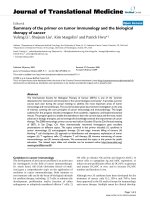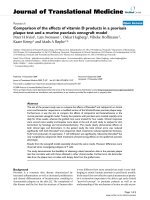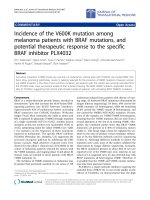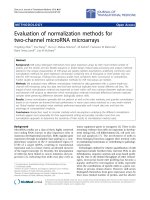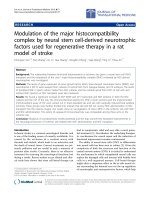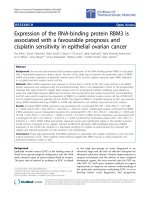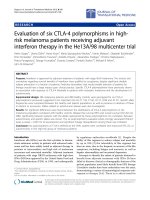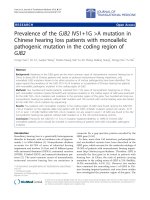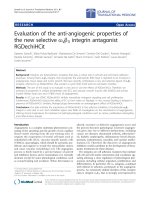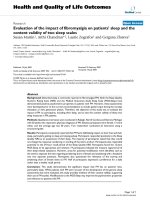báo cáo hóa học:" Evaluation of the tuberculin skin test and the interferon-γ release assay for TB screening in French healthcare workers" ppt
Bạn đang xem bản rút gọn của tài liệu. Xem và tải ngay bản đầy đủ của tài liệu tại đây (256.27 KB, 7 trang )
BioMed Central
Page 1 of 7
(page number not for citation purposes)
Journal of Occupational Medicine
and Toxicology
Open Access
Research
Evaluation of the tuberculin skin test and the interferon-γ release
assay for TB screening in French healthcare workers
Dominique Tripodi*
1
, Benedicte Brunet-Courtois
1
, Virginie Nael
1
,
Marie Audrain
2
, Edmond Chailleux
3
, Patrick Germaud
3
, Frederique Naudin
4
,
Jean-Yves Muller
2
, Martine Bourrut-Lacouture
1
, Marie-Henriette Durand-
Perdriel
1
, Claire Gordeeff
1
, Guyonne Guillaumin
1
, Marietherese Houdebine
1
,
Francois Raffi
5
, David Boutoille
5
, Charlotte Biron
5
, Gilles Potel
6
,
Claude Roedlich
1
, Christian Geraut
1
, Anja Schablon
7
and Albert Nienhaus
7
Address:
1
Department of Occupational Medicine and Occupational Hazards, University Hospital of Nantes, France,
2
Department of Immunology,
University Hospital of Nantes, France,
3
Department of Pneumology, Laënnec Hospital, University Hospital of Nantes, France,
4
Tuberculosis Public
Health Clinic, 6 rue Hippolyte Durand Gasselin, Nantes, France,
5
Department of the Infectious and Tropical illnesses, Hospital, CHU Nantes,
France,
6
Emergency Department, University Hospital of Nantes, France and
7
Accident Insurance and Prevention in the Health and Welfare Services,
Germany
Email: Dominique Tripodi* - ; Benedicte Brunet-Courtois - ;
Virginie Nael - ; Marie Audrain - ; Edmond Chailleux - ;
Patrick Germaud - ; Frederique Naudin - ; Jean-Yves Muller - JY.Muller@chu-
nantes.fr; Martine Bourrut-Lacouture - ; Marie-Henriette Durand-Perdriel - Marie-Henriette.Durand-
; Claire Gordeeff - ; Guyonne Guillaumin - ;
Marietherese Houdebine - ; Francois Raffi - ;
David Boutoille - ; Charlotte Biron - ; Gilles Potel - ;
Claude Roedlich - ; Christian Geraut - ; Anja Schablon - ;
Albert Nienhaus -
* Corresponding author
Abstract
Introduction: Using French cut-offs for the Tuberculin Skin Test (TST), results of the TST were
compared with the results of an Interferon-γ Release Assay (IGRA) in Healthcare Workers (HCW)
after contact to AFB-positive TB patients.
Methods: Between May 2006 and May 2007, a total of 148 HCWs of the University Hospital in
Nantes, France were tested simultaneously with IGRA und TST. A TST was considered to indicate
recent latent TB infection (LTBI) if an increase of >10 mm or if TST ≥ 15 mm for those with no
previous TST result was observed. For those with a positive TST, chest X-ray was performed and
preventive chemotherapy was offered.
Results: All HCWs were BCG-vaccinated. The IGRA was positive in 18.9% and TST ≥ 10 mm was
observed in 65.5%. A recent LTBI was believed to be highly probable in 30.4% following TST.
Agreement between IGRA and TST was low (kappa 0.041). In 10 (16.7%) out of 60 HCWs who
needed chest X-ray following TST the IGRA was positive. In 9 (20%) out of 45 HCWs to whom
preventive chemotherapy was offered following TST the IGRA was positive. Of those considered
Published: 30 November 2009
Journal of Occupational Medicine and Toxicology 2009, 4:30 doi:10.1186/1745-6673-4-30
Received: 6 August 2009
Accepted: 30 November 2009
This article is available from: />© 2009 Tripodi et al; licensee BioMed Central Ltd.
This is an Open Access article distributed under the terms of the Creative Commons Attribution License ( />),
which permits unrestricted use, distribution, and reproduction in any medium, provided the original work is properly cited.
Journal of Occupational Medicine and Toxicology 2009, 4:30 />Page 2 of 7
(page number not for citation purposes)
TST-negative following the French guidelines, 20.5% were IGRA-positive. In a two-step strategy -
positive TST verified by IGRA - 18 out of 28 (64.3%) IGRA-positive HCWs would not have been
detected using French guidelines for TST interpretation.
Conclusion: The introduction of IGRA in contact tracings of BCG-vaccinated HCWs reduces X-
rays and preventive chemotherapies. Increasing the cut-off for a positive TST does not seem to be
helpful to overcome the effect of BCG vaccination on TST.
Introduction
The increased risk of healthcare workers (HCWs) for
tuberculosis is well established [1,2]. Therefore screening
healthcare workers (HCWs) for latent tuberculosis infec-
tion (LTBI) and active tuberculosis (TB) is fundamental in
infection control programs in hospitals [3]. For about a
century, the Tuberculin Skin Test (TST) has been used to
detect LTBI. However the TST has its known limitations,
including cross-reactivity with BCG and non-tubercular
mycobacteria (NTM) infections [4]. Advances in molecu-
lar biology have led to the development of new in-vitro
assays that measure interferon (INF)-γ released by sensi-
tized T-cells after stimulation with M. tuberculosis antigens.
These tests are more specific than the TST because they use
antigens not shared by any of the BCG vaccine strains nor
by the more common species of NTM (e.g. M. avium) [5].
Besides the higher specificity and at least equal sensitivity
as the TST, IGRAs correlate better with surrogate measures
of exposure to M. tuberculosis [6-8] and have a higher pre-
dictive value for LTBI progression to active TB in close
contacts in low-incidence settings [9].
So far several systematic investigations of LTBI in HCWs
using TST and IGRA have been published [10-18] show-
ing a high proportion of TST-positive/IGRA-negative
HCWs which is most likely explained by BCG vaccination.
In order to reduce the effect of BCG vaccination on TST,
the French guidelines for TST interpretation propose high
cut points for the TST - increase >10 mm or ≥ 15 mm if no
earlier TST is available [19]. Alternatively to high cut-offs
for TST, a number of European Guidelines on the use of
IGRAs suggest use of a two-step strategy - performing an
IGRA in those initially positive by the TST and excluding
LTBI in those IGRA-negative [20-22]. In our study we
compared the performance of the TST and IGRA in French
HCWs when using a high cut-off for the TST.
Materials and methods
Study setting and study subjects
In France the TB incidence in the general population has
been declining for several years and was as low as 5.2 cases
per 100,000 inhabitants in 2006 [23]. However, increas-
ing differences regarding region and risk groups are seen.
Most cases are observed in urban areas and the incidence
rate in foreign-born inhabitants was 38.8/100,000).
The population of this cross-sectional study comprises all
workers of the University Hospital of Nantes, France, who
participated in TB screening from May 2006 through May
2007 because of contact to infectious TB patients or mate-
rials. The University Hospital of Nantes is the largest hos-
pital in the Nantes region and serves as a referral center for
TB patients throughout the region. Unprotected contact of
the HCWs to acid-fast bacillus (AFB)-positive patients
occurred in the emergency department and lasted
between 1 and 2 hours. Screening was performed 8 to 10
weeks after exposure.
Screening was performed using TST and IGRA simultane-
ously. Following French guidelines chest X-ray in order to
exclude active TB was performed when TST was ≤ 10 mm
if no previous TST was available for comparison [19]. If a
previous TST was available, X-ray was performed when
TST increased by >10 mm (Figure 1). Preventive chemo-
therapy is proposed if recent LTBI is very probable (TST ≥
15 mm and no previous TST available or increase >10 mm
in TST). For the purpose of this study agreement between
IGRA and TST was also analyzed using ≥ 10 mm as cut-off
for the TST.
BCG vaccination was assessed through the individual vac-
cination record or by scars. Following the national vacci-
nation plan, BCG vaccination for newborns is mandatory
in France and until 2008 was repeated if TST was <5 mm
[23]. Therefore every HCW has been vaccinated at least
once. All participating HCWs were French-born.
TST was performed by trained personnel following stand-
ard procedures. In brief, 0.1 mL (2 TU) of purified protein
derivate (Tubertest from SanofiPasteur) was injected
intradermally at the volar side of the forearm and the
transverse diameter of the induration was read after 72 to
96 hours [19]. A diameter ≥ 10 mm was considered posi-
tive.
Before TST application, the interview was performed and
blood for the IGRA was drawn. The interview covered age,
gender, BCG vaccination history and employment in
healthcare. As IGRA, the QuantiFERON
®
-TB Gold In-Tube
Assay (Cellestis Limited, Carnegie, Australia) was admin-
istrated following the manufacturer's protocol. Observers
were blinded to the results of the TST and vice versa.
Journal of Occupational Medicine and Toxicology 2009, 4:30 />Page 3 of 7
(page number not for citation purposes)
Statistical analysis
Chi-square tests were used for categorical data. Kappa was
calculated for the agreement between IGRA and TST.
Adjusted odds ratios (OR) and 95% confidence intervals
(CI) were calculated for putative predictive variables using
conditional logistic regression. Model building was per-
formed backwards using the chance criteria for variable
selection [24].
All persons gave their informed consent prior to their
inclusion in the study. No ethics approval of the study was
needed because no examinations in addition to those
needed for contact tracing were performed.
Results
The study population comprises 148 HCWs. The charac-
teristics of the study population are described in Table 1.
Repeated BCG vaccination had 62.2%. For 83.1% the last
vaccination was performed more than 20 years before. No
undetermined result of the QFT was observed. A positive
QFT was observed in 18.9% and a TST ≥ 10 mm in 65.5%
(Table 2). The QFT was positive in 9.8% of those with a
TST 0-9 mm and in 21.1% of those with a TST ≥ 20 mm.
The association between TST diameter and QFT positivity
was weak (p for test for trend: 0.081).
In 8 persons an increase >10 mm of the TST was observed
but only one out of these 8 HCWs (12.5%) had a positive
IGRA (Table 3). Most persons (35.1%) had an increase of
the TST ≥ 10 mm. 25.0% of the HCWs pertaining to this
category were IGRA-positive. No statistically significant
association was found between the different TST results
and QFT positivity (p = 0.58). Of the 28 HCWs positive in
QFT 10 (35.7%) were considered for X-ray or preventive
chemotherapy following French interpretation of the TST.
Again, following French Guidelines for TST interpretation
a recent LTBI was very probable in 45 (30.4%) HCWs
(Table 4). Of these, 20% were positive in the QFT which
is a proportion similar to the one of those for whom a
recent LTBI was not suspected (18.4%). Compared to the
French definition for very probable recent LTBI a cut-off of
≥ 10 mm increased the kappa value for agreement
Decision tree for TST interpretation in contact tracing for contacts of AFB-positive TB patients following [19]Figure 1
Decision tree for TST interpretation in contact tracing for contacts of AFB-positive TB patients following [19].
The French guidelines for TST interpretation in HCWs are presented.
Chest
X-ray
Therapy of
active TB
Preventive
chemotherapy
Increase compared to
previous TST: >10 mm
Repeat TST in 3
and 12-18 months
TST 10 -
<15 mm
combined with
recent exposure,
recent LTBI
probable
TST
15 mm
recent LTBI very
probable
Chest
X-ray
Therapy of
active TB
Preventive
chemotherapy
No previous
TST
TST
5 -
<10 mm
old LTBI probable,
no recent LTBI
Journal of Occupational Medicine and Toxicology 2009, 4:30 />Page 4 of 7
(page number not for citation purposes)
between TST and QFT slightly from 0.02 to 0.11. But in
both strategies agreement between TST and QFT was weak
or non existent.
Using ≥ 10 mm as cut-off for the TST regardless of an ear-
lier TST, TST+/QFT- discordance was observed in 74
(50%) HCWs and TST-/QFT+ discordance in 5 (3.4%) out
of 148 exposed HCWs. In those with TST ≥ 10 mm 23.7%
were positive in the QFT.
X-ray was performed in 60 HCWs and no active TB was
found. Chemoprevention was proposed to 45 HCWs
(Table 3). Logistic regression did not reveal any associa-
tion between positive QFT or positive TST and age, gen-
der, BCG vaccination, or years spent in healthcare. This
was also true when instead of the French definitions the
cut-off for TST was reduced to ≥ 10 mm regardless of ear-
lier TST results (data not shown).
In a two-step strategy - performing QFT in HCWs with sus-
pected recent LTBI following TST - 10 (1+8+1) instead of
60 (16.7%) would have been proposed for X-ray. On the
other side, using this two-step approach with a high cut-
off for the TST would allow to detect 10 out of 28 (35.7%)
HCWs positive in the QFT only (Table 3). Using a cut-off
of ≥ 10 mm for the TST in a two-step strategy would
decrease the number of QFTs needed in this population
from 100% to 65.5%, again with the drawback that 5 out
of 28 (17.9%) HCWs positive in the QFT would be missed
(Table 4).
Discussion
To our knowledge this is the first study that compared the
performance of TST and QFT when screening French
HCWs. In those in which recent LTBI was suspected fol-
lowing French guidelines [19], the confirmation rate of
the QFT was not higher than in those in whom recent LTBI
was not probable. Only about one third (35.7%) of those
positive in QFT were also considered positive in TST,
which is a rate lower than that reported in other studies
[10,16,18]. Therefore, our data suggest that the French
guidelines for the interpretation of TST in exposed HCWs
should be reconsidered. Agreement between TST and QFT
was better with ≥ 10 mm as cut-off for TST but still
remained weak (kappa = 0.11). Following our data nei-
ther increasing the cut-off for TST nor a two-step strategy
(IGRA only in TST-positive HCWs) seemed to reduce the
influence of BCG vaccination on TST results in a satisfying
way.
Positive in QFT were 18.9% of the HCWs with recent con-
tact to an AFB-positive TB case were positive in the QFT.
Table 1: Description of the study population (n = 148)
Age N %
20-29 years 42 28.4
30-39 years 29 19.6
40-49 years 41 27.7
50-60 years 36 24.3
Gender
Female 109 73.6
Male 39 26.4
BCG vaccination
One 56 37.8
Two or more 92 62.2
Years since last vaccination
≤ 20 years 25 16.9
>20-30 years 37 25.0
>30 years 86 58.1
Years in healthcare
≤ 10 years 78 52.7
>10 years 70 47.3
Table 2: TST diameter by IGRA results
QFT
Negative Positive Total
TST N Row% N Row% N Col%
0-9 mm 46 90.2 5 9.8 51 34.5
10-14 mm 25 80.2 6 19.4 31 20.9
15-19 mm 19 67.9 9 32.1 28 18.9
20-40 mm 30 78.9 8 21.1 38 25.7
All 120 81.1 28 18.9 148 100.0
P-value for trend: 0.081
TST = Tuberculin Skin Test
QFT = Quantiferon TB Gold in tube
Row% = Row-Percent
Col% = Column-Percent
Journal of Occupational Medicine and Toxicology 2009, 4:30 />Page 5 of 7
(page number not for citation purposes)
The rate of positive QFT is lower than the one (33%)
observed in Portuguese HCWs [25] but lower than the
one (10%) observed in German HCWs [16,18].
As reported in another study [26] we observed an associa-
tion between the diameter of the TST and the probability
of a positive QFT even though the test for trend was of
borderline statistical significance. This might be due to the
small sample size (n = 148) of our study. The number of
TST-/QFT+ HCWs in our population is much higher than
in two meta-analyses [8,26]. But surprisingly, even though
the criteria for a positive TST following French guidelines
are high compared to other countries, the proportion of
TST+/QFT- HCWs was high, too. The risk of progression to
active TB in TST+/QFT- HCWs is unknown. A number of
publications suggest it is low [9,27-29]. Because of the
high sensitivity of the IGRA and the low specificity of the
TST, none of the several national guidelines recommend
X-ray or chemoprevention in HCWs with a positive TST
and a negative IGRA [20-22]. Therefore it seems reasona-
ble to assume that most TST+/QFT- results do not indicate
infection with Mycobacteria tuberculosis.
Introducing IGRA for TB screening in France would reduce
the number of X-rays and the preventive chemotherapies
by a high proportion (from 65.5% for TST ≥ 10 mm or
from 40.5% for TST interpretation following French
guidelines to 18.9%). We did not conduct a cost-effective-
Table 3: QFT results for different TST outcomes
QFT
Negative Positive Total
TST (p = 0.58) N (row%) N (row%) N (col%) X-ray Chemo
Increase >10 mm 7 (87.5) 1 (12.5) 8 (5.4) yes yes
≥ 15 mm, no earlier TST 29 (78.4) 8 (21.6) 37 (25.0) yes yes
≤ 10-<15 mm, no earlier TST 14 (93.3) 1 (6.7) 15 (10.1) yes no
≥ 5-<10 mm, no earlier TST 16 (84.2) 3 (15.8) 19 (12.8) no no
Increase ≥ 10 mm 39 (75.0) 13 (25.0) 52 (35.1) no no
<5 mm, no earlier TST 15 (88.2) 2 (11.8) 17 (11.5) no no
Chemo = preventive chemotherapy proposed
TST = Tuberculin Skin Test
QFT = Quantiferon TB Gold in tube
Row% = Row-Percent
Col% = Column-Percent
Table 4: Kappa-values and QFT results for TST indicating recent LTBI and TST ≥ 10 mm
QFT
Negative Positive Total
Recent LTBI very probable N (row%) N (row%) N (col%) Kappa
No 84 (81.6) 19 (18.4) 103 (69.6)
Yes 36 (80.0) 9 (20.0) 45 (30.4) 0.02
TST ≥ 10 mm, regardless of earlier TST
Negative 46 (90.2) 5 (9.8) 51 (34.5)
Positive 74 (76.3) 23 (23.7) 97 (65.5) 0.11
TST+/QFT- 74 (50% of all), TST-/QFT+ 5 (17.9% of all QFT+)
Journal of Occupational Medicine and Toxicology 2009, 4:30 />Page 6 of 7
(page number not for citation purposes)
ness analysis. But nevertheless our analysis corroborates
the findings of other cost-benefit analyses. A German cost-
effectiveness analysis based on German data on TST and
QFT positivity and costs of treatment showed that using
the QFT assay, but especially combining the QFT assay fol-
lowing the TST screening of close contacts at a cut-off
induration size of 5 mm before LTBI treatment, is highly
cost-effective in reducing the disease burden of TB [30].
Similar results were observed in an analysis of a hypothet-
ical cohort based on data from Switzerland [31] and Can-
ada [32]. There is still an ongoing debate as to whether the
introduction of IGRA in TB screening reduces the costs for
BCG-vaccinated contacts only [33] or for both vaccinated
and non-vaccinated contacts [34]. It is still unknown for
how long the QFT remains positive after elimination of
Mycobacterium tuberculosis from the body either spontane-
ously or after chemoprevention [35,36].
So far the risk of progression towards active tuberculosis
for those with TST-/QFT+ combinations is unknown. The
well-established high specificity of the QFT and the
known limitations of TST sensitivity [8] suggest that this
combination indicates infections with Mycobacterium
tuberculosis. Following our data a two-step strategy using ≥
10 mm as cut-off for a positive TST helps to reduce unwar-
ranted X-rays but risks to miss a high proportion (17.9%)
of the HCWs positive in QFT and therefore likely infected
with Mycobacterium tuberculosis. Further reducing the cut-
off for a positive TST to >5 mm would not be useful in our
population because already 65% had a TST ≥ 10 mm.
Conclusion
Our data show that the increase criteria (increase >10
mm) for TST interpretation lead to a low sensitivity of the
TST without reducing the specificity problems of the TST
in a meaningful way. Therefore the use of the increase cri-
teria should be reconsidered. Furthermore it could be
shown that a two-step strategy - IGRA if TST ≥ 10 mm -
might also lead to a low sensitivity of a TB screening.
Therefore our data suggest that IGRA should replace TST
when screening HCWs for tuberculosis.
Competing interests
The authors declare that they have no competing interests.
Authors' contributions
DT designed the study and was involved in data collection
and writing of the paper.
BBC was involved in data collection and gave critical com-
ments for manuscript writing.
VN was involved in data collection and gave critical com-
ments for manuscript writing.
MA was involved in data collection and gave critical com-
ments for manuscript writing.
EC was involved in data collection and gave critical com-
ments for manuscript writing.
PG was involved in data collection and gave critical com-
ments for manuscript writing.
FN was involved in data collection and gave critical com-
ments for manuscript writing.
JYM was involved in data collection and gave critical com-
ments for manuscript writing.
MBL was involved in data collection and gave critical
comments for manuscript writing.
MHDP was involved in data collection and gave critical
comments for manuscript writing.
CG was involved in data collection and gave critical com-
ments for manuscript writing.
GG was involved in data collection and gave critical com-
ments for manuscript writing.
MTH was involved in data collection and gave critical
comments for manuscript writing.
FR was involved in data collection and gave critical com-
ments for manuscript writing.
DB was involved in data collection and gave critical com-
ments for manuscript writing.
CB was involved in data collection and gave critical com-
ments for manuscript writing.
GP was involved in data collection and gave critical com-
ments for manuscript writing.
CR was involved in data collection and gave critical com-
ments for manuscript writing.
CG was involved in data collection and gave critical com-
ments for manuscript writing.
AN analysed the data and drafted the manuscript.
All authors read and approved the final manuscript.
Acknowledgements
We wish to thank all HCWs who participated in the study.
Journal of Occupational Medicine and Toxicology 2009, 4:30 />Page 7 of 7
(page number not for citation purposes)
References
1. Seidler A, Nienhaus A, Diel R: Review of epidemiological studies
on the occupational risk of tuberculosis in low-incidence
areas. Respiration 2005, 72(4):431-446.
2. Diel R, Seidler A, Nienhaus A, Rusch-Gerdes S, Niemann S: Occupa-
tional risk of tuberculosis transmission in a low-incidence
area. Respir Res 2005, 6(1):35-45.
3. CDC - Center for Disease Control and Prevention: Guidelines for
Preventing the Transmission of Mycobacterium tuberculosis
in Healthcare Settings, 2005. MMWR 2005, 54(No RR-
17):1-141.
4. Menzies D: What does tuberculin reactivity after Bacille Cal-
mette-Guerin vaccination tell us? Clin infect Dis 2000, 31(Suppl
3):S71-S74.
5. Andersen P, Munk ME, Pollock JM, Doherty TM: Specific immune-
based diagnosis of tuberculosis. Lancet 2000,
356(9235):1099-1104.
6. Nahid P, Pai M, Hopewell PC: Advances in the diagnosis and
treatment of tuberculosis. Proc Am Thorac Soc 2006, 3:103-110.
7. Pai M, Riley LW, Colford JM: Interferon-gamma assays in the
immunodiagnosis of tuberculosis: a systematic review. Lancet
Infect Dis 2004, 4:761-776.
8. Menzies D, Pai M, Comstock G: Meta-analysis: New tests for the
diagnosis of latent tuberculosis infection: Areas of uncer-
tainty and recommendations for research. Ann Intern Med
2007, 146:340-352.
9. Diel R, Loddenkemper R, Meywald-Walter K, Niemann S, Nienhaus
A: Predictive value of a whole-blood IFN-{gamma} assay for
the development of active TB disease. Am J Respir Crit Care Med
2008, 177:1164-1170.
10. Harada N, Nakajima Y, Higuchi K, Sekiya Y, Rothel J, Mori T: Screen-
ing for tuberculosis infection using whole-blood interferon-γ
and Mantoux testing among Japanese healthcare workers.
Infection control and hospital epidemiology 2006, 27(5):442-448.
11. Soberg B, Andersen AB, Larsen HK, Weldingh K, Andersen P,
Kofoerd K, Ravn P: Detecting a low prevalence of latent tuber-
culosis among health care workers in Denmark detected by
M: tuberculosis specific INF-
γ whole-blood test. Scandinavian
Journal of Infectious Diseases 2007, 39:554-559.
12. Kobashi Y, Obase Y, Fukuda M, Yoshida K, Miyashita N, Fujii M, Oka
M: Usefulness of QuantiFERON TB-2G, a diagnostic method
for latent tuberculosis infection, in a contact investigation of
health care workers. Intern Med 2007, 46(18):1543-9.
13. Mirtskhulava V, Kempker R, Shields KL, Leonard MK, Tsertsvadze T,
del Rio C, Salakaia A, Blumberg HM: Prevalence and risk factors
for latent tuberculosis infection among health care workers
in Georgia. Int J Tuberc Lung Dis 2008, 12(5):513-519.
14. Nienhaus A, Schablon A, Siano B, le Bacle C, Diel R: Evaluation of
the interferon-gamma release assay in healthcare workers.
Int Arch Occup Environ Health 2008, 81:295-300.
15. Lee SS-J, Liu Y-C, Huang T-S, Chen Y-S, Tsai H-C, Wann S-R, Lin H-
H: Comparison of the interferon-γ release assay and the
tuberculin skin test for contact investigation of tuberculosis
in BCG-vaccinated health care workers. Scandinavian Journal of
Infectious Disease 2008, 40(5):373-80.
16. Schablon A, Beckmann G, Harling M, Diel R, Nienhaus A: Preva-
lence of latent tuberculosis infection among healthcare
workers in a hospital for pulmonary diseases. J Occup Med Tox-
icol 2009, 4:1.
17. Vinton P, Mihrshahi S, Johnson P, Jenkin GA, Jolley D, Biggs BA: Com-
parison of QuantiFERON-TB Gold In-Tube test and tubercu-
lin skin test for identification of latent Mycobacterium
tuberculosis infection in healthcare staff and association
between positive test results and known risk factors for
infection. Infection Control and Hospital Epidemiology 2009, 30(3):.
online first
18. Ringshausen FC, Schlösser S, Nienhaus A, Schablon A, Schultze-
Werninghaus G, Rohde G: In-hospital contact investigation
among health care workers after exposure to smear-nega-
tive tuberculosis. J Occup Med Tox 2009, 4:11.
19. French guidelines for TB screening in HCWs: Investigations à con-
duire autour d'un cas de tuberculose-maladie ou tubercu-
lose-infection récente. Revue des Maladies Infectieuses 2004,
34:391-396.
20. National Institute for Health and Clinical Excellence: Tuberculosis:
clinical diagnosis and management of tuberculosis, and
measures for its prevention and control. London 2006.
21. Zellweger JP, Zellweger A, Ansermet S, de Senarclens B, Wrighton-
Smith P: Contact tracing using a new T-cell-based test: better
correlation with tuberculosis exposure than the tuberculin
skin test. Int J Tuberc Lung Dis 2005, 9:1242-1247.
22. Diel R, Forssbohm M, Loytved G, Haas W, Hauer B, Maffei D, Mag-
dorf K, Nienhaus A, Rieder HL, Schaberg T, Zellweger JP, Lod-
denkemper R: Recommendations for environmental contact
tracing in tuberculosis. German Central Committee against
Tuberculosis. Gesundheitswesen 2007, 69:488-503.
23. Che D, Lefebvre N, Antoun F, Fraisse P, Depinoy M, Antoine D, Farge
D, Paty MC: Tuberculosis in France: New Challenges for the
practitioners. La Revue de Médecine Interne 2009, 30:142-9.
24. Hosmer D, Lemeshow S: Applied Logistic Regression. New
York, NY: John Wiley & Sons; 2000.
25. Torres Costa J, Sá R, Cardoso MJ, Silva R, Ferreira J, Ribeiro C,
Miranda M, Plácido JL: Nienhaus. Tuberculosis screening in Por-
tuguese healthcare workers using the Tuberculin Skin Test
and the Interferon-γ release assay. Eur Resp J 2009,
34(6):1423-1428.
26. Nienhaus A, Schablon A, Diel R: Interferon-γ release assay for
the diagnosis of latent TB infection - analysis of discordant
results, when compared to the tuberculin skin test. PLoS ONE
2008, 3(7):e2665.
27. Higuchi K, Harada N, Mori T, Sekiya Y: Use of QuantiFERON-TB
Gold to investigate tuberculosis contacts in a high school.
Respirology 2007, 12(1):88-92.
28. Higuchi K, Kondo S, Wada M, Hayashi S, Ootsuka G, Sakamoto N,
Harada N: Contact investigation in a primary school using a
whole-blood interferon-gamma assay. I Infect 2009,
58(5):352-7.
29. Aichelburg MC, Rieger A, Breitenecker F, Pfistershammer K, Tittes J,
Eltz S, Aichelburg AC, Stingl G, Makristathis A, Kohrgruber N:
Detection and Prediction of Active Tuberculosis Disease by
a Whole-Blood Interferon-gamma Release Assay in HIV-1-
Infected Individuals. Clin Infect Dis 2009, 48(7):954-62.
30. Diel R, Nienhaus A, Loddenkemper R: Cost-effectiveness of inter-
feron-gamma release assay screening for latent tuberculosis
infection treatment in Germany. Chest 2007, 131:1424-1434.
31. Diel R, Wrighton-Smith P, Zellweger JP: Cost-effectiveness of
interferon-gamma release assay testing for the treatment of
latent tuberculosis. Eur Respir J 2007, 30:321-332.
32. Oxlade O, Schwartzman K, Menzies D: Interferon-gamma
release assays and TB screening in high-income countries: a
cost-effectiveness analysis. Int J Tuberc Lung Dis 2007,
11(1):16-26.
33. Marra F, Marra CA, Sadatsafavi M: Cost-effectiveness of a new
interferon-based blood assay, QuantiFERON-TB Gold, in
screening tuberculosis contacts. Int J Tuberc Lung Dis 2008,
12:1414-1424.
34. De Perio MA, Tsevat J, Roselle GA: Cost-effectiveness of inter-
feron gamma release assays vs tuberculin skin tests in health
care workers. Arch Intern Med 2009, 169:179-187.
35. Mack U, Migliori GB, Sester M, Rieder HL, Ehlers S, Goletti D, Bossink
A, Magdorf K, Hölscher C, Kampmann B, Arend SM, Detjen A, Both-
amley G, Zellweger JP, Milburn H, Diel R, Ravn P, Cobelens F, Car-
dona PJ, Kann B, Solovic I, Duarte R, Cirillo DM, Lange C: LTBI:
latent tuberculosis infection or lasting immune responses to
M. tuberculosis? - A TBNET consensus statement. Eur Respir
J 2009, 33:956-73.
36. Pai M, Joshi R, Dogra S, Mendiratta DK, Narang P, Dheda K, Kalantri
S: Persistently elevated T cell interferon-γ response after
treatment for latent tuberculosis infection among health-
care workers in India: a preliminary report. Journal of Occupa-
tional Medicine and Toxicology 2006, 1:7.
